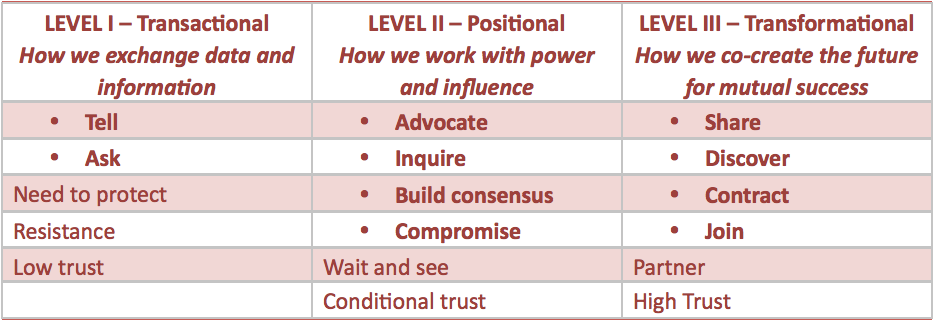
Conversational IQ: 5 Conversational Blind Spots
“Human beings are the most highly social species on this planet. When we succeed in connecting deeply with others – heart to heart and head to head – trust is at its all-time high, and people work in concert in extraordinary ways.”
~ Judith E. Glaser, Conversational Intelligence: How Great Leaders Build Trust & Get Extraordinary Results (Bibliomotion, Inc., 2013)
Scientists are discovering how conversations cause a rapid cascade of neurochemicals in the brain, laying the foundation for trust or distrust.
To remain competitive, leaders must understand the powerful conversational rituals that prime the brain for trust, partnership and mutual success.
Conversations are more than a vehicle for sharing information. As social beings, our interactions involve words that trigger powerful physical and emotional responses. Our words can facilitate healthy, trusting conversations – or cause others to shut down with fear, caution and worry.
When you promote shared understanding through conversations, you can unleash others’ full potential. As Glaser explains:
“The premise of Conversational Intelligence is: To get to the next level of greatness depends on the quality of our culture, which depends on the quality of our relationships, which depends on the quality of our conversations. Everything happens through conversations!”
Our minds toggle through a series of questions to determine the kind of engagement we’ll have with each other.
5 Subconscious Questions
Even before we open our mouths, we size up other people and determine whether we can trust them. In a fraction of a second, you sense whether you need to:
- Protect: Do I need to be on guard – and how?
- Connect: Can I trust this person?
- Belong: Where do I belong? Do I fit in?
- Be Strong: What do I need to be successful?
- Partner: How do I create value with others?
 This process takes place between the brain’s primitive emotional centers and the neocortex, its seat of reason and judgment.
This process takes place between the brain’s primitive emotional centers and the neocortex, its seat of reason and judgment.
Bad conversations trigger our distrust network; good conversations trigger our trust network. This influences what we say, as well as how and why we say it. Our trust and distrust networks shape each conversation’s outcome.
Leadership Conversations
If you project positive intentions, your employees will likely respond to questions positively and feel more confident about taking risks and accomplishing tasks.
When you offer support and praise, employees believe you trust them and will go the extra mile. Positive conversations obviate worries about belonging.
Feel–good conversations trigger higher levels of dopamine, oxytocin, endorphins and other chemicals that provide a sense of well-being and drive our state of mind. They foster trusting relationships and influence our response to our coworkers and organizational demands.
Conflict and Conversations
 Negative conversations can occur despite our best intentions. Others internalize messages based on what they think we said – not our actual words. As Glaser notes:
Negative conversations can occur despite our best intentions. Others internalize messages based on what they think we said – not our actual words. As Glaser notes:
“Unhealthy conversations are at the root of distrust, deceit, betrayal and avoidance – which leads to lower productivity and innovation, and ultimately, lower success.”
When you want to win and subsequently fight hard, you may go into overdrive as you persuade others to adopt your point of view. You push instead of attempting to pull others in your desired direction.
If you try to win at all costs, your conversations will trigger others’ primitive fight-or-flight response. Your conversation partner’s brain will effectively shut down, and he’ll no longer be open to influence. Your conversation will hit a dead end.
Open interactions require you to be perceived as friend, not foe.
3 Conversation Levels
Leaders commonly rely on two types of conversations: telling and selling.
When telling, they try to clearly specify what employees need to do. When selling, they try to persuade them with reasons for doing it. Unfortunately, some leaders resort to yelling or repeating themselves, and they wonder why they never get the results they want.
Employees may understand “what” to do and even “why” they should do it. But they’ll never fully engage unless they’re part of meaningful conversations that encourage connection, sharing and discovery. When we respect others’ worldviews (especially when they differ from our own), we create a space for better conversations and allow new ideas to emerge.
The following table offers a graphic representation of Glaser’s identified conversation levels:

Only when we participate in Level III conversations can we transform ourselves and our conversation partners by sharing thoughts, ideas and belief systems. When we’re mindful of our intentions and notice the impact our words have on others, we begin to live in Level III. We realize that: Too often, we get stuck in Level II conversations because we’re addicted to being right. We fail to realize the negative impact this has on others. We may start out with an exchange of ideas, but we then become trapped in a power dance. It can be hard to let go of the need to win, but it’s critical to take this step to avoid interactions that are merely a contest of wills.
- We shape the meanings our words have on others.
- We need to validate our words’ true meanings.
- Breakdowns occur when others interpret our words in unanticipated ways.
- Breakdowns occur when we try to persuade others that our meanings are the right ones.
- Breakthroughs occur when we take time to share and discover.
- Breakthroughs occur when we co-create and partner to create a shared reality.
Reality Gaps
Conflicts commonly arise when there’s a reality gap (an opposing interpretation of reality). They trigger an array of fears that activate our distrust network. We begin to process reality through a fear-based (vs. trust-based) lens. We start to make stuff up.
When we talk past one another, we are conversationally blind. We become focused on making a point and persuading others we’re right. Winning becomes the goal instead of co-creating a shared solution.
In some studies, executives were found to use statements 85 percent of the time, asking questions only 15 percent of the time. Even their questions often turned out to be statements in disguise.
One’s conversational ability isn’t necessarily innate, but you can improve upon it. Conversation partners must agree to share thoughts, ideas and beliefs to co-create a shared sense of mutual reality.
Conversational Blind Spots
 It’s all too easy for us to retreat into our biases, assumptions and conversational blind spots. This invariably leads to misunderstandings, miscommunications, conflicts and negative relationships.
It’s all too easy for us to retreat into our biases, assumptions and conversational blind spots. This invariably leads to misunderstandings, miscommunications, conflicts and negative relationships.
Five common conversational blind spots plague us.
Blind Spot #1: False Assumptions
When we assume others see what we see, feel what we feel and think what we think, we’re operating with blinders on. If you’re engrossed in your own point of view, you can’t connect with another’s perspective.
Sensitive people pick up on others’ lack of connectivity, and they’ll push harder to persuade others that they’re right. Their payoff is a burst of dopamine that may feel great, but it leaves their conversation partners in the dust.
Blind Spot #2: Underestimating Emotions
Words can trigger strong emotions: trust, distrust, excitement and fear. When this happens, we may misinterpret reality. If we feel threatened, we move into protective behaviors and fail to realize we’re doing so. When we’re afraid, the brain releases chemicals that shut down its logic centers.
Blind Spot #3: Lack of Empathy
Fear prevents us from empathizing with others. We become insensitive to others’ perspectives and cannot hear important parts of the conversation. When we’re able to listen deeply, without judgment, we can feel what others are feeling.
Blind Spot #4: Making Our Own Meaning
We assume that we remember what others say. In truth, we actually remember our responses to what others say. Research shows that:
- We drop out of conversations every 12-18 seconds to process what others are saying.
- A chemical process within the brain seizes on our responses to others’ words – and these responses form the basis of memory.
Blind Spot #5: Assuming Shared Meaning
We assume that the person speaking creates the message’s meaning. In truth, the listener decodes the message and assigns meaning to it. As a listener, you run a speaker’s words through your personal vault of memories and experiences and attempt to make sense of the conversation.
Two conversation partners can’t be sure they’re on the same page until they take the time to validate a shared meaning.
Improve Your Conversations
 You can take several basic steps to enhance the quality of your conversations:
You can take several basic steps to enhance the quality of your conversations:
- Slow down. A conversation is not a race.
- Breathe deeply. Take appropriate pauses. Allow time to process conversations.
- Check your emotions.
- Ask discovery questions.
- Validate shared goals and meanings.
If you’re like many leaders, you tend to march forward at a breakneck pace to achieve goals and objectives – a pattern that prevents you from seeing the impact your conversations have on others. You may forget that your words are rarely neutral and have histories informed by years of use. Every experience you have adds a new layer of meaning to your conversations.
It’s crucial to work on managing any underlying feelings of rejection and protection. Only then can you harness your ability to reach out to others and achieve mutual understanding.
